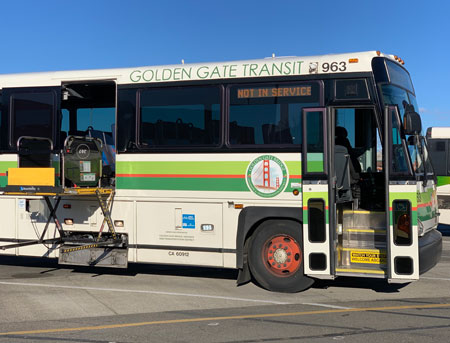The Golden Gate Bridge Highway and Transportation District is committed to ensuring that the District complies with all Federal Americans with Disabilities Act (ADA) regulations as well as the State of California accessibility requirements.
Questions related to the accessibility of Golden Gate Transit buses, Golden Gate Ferry vessels, or District facilities, may be directed to Jon Gaffney, ADA Compliance and Program Manager, at 415-257-4416 or jgaffney@goldengate.org. If requested by an individual with a disability, the District will provide a language or sign interpreter or other accessible format at any District public meeting. Please contact Mr. Gaffney for assistance.

Boarding & Disembarking
Persons requiring special assistance are encouraged to arrange for a companion to ride with them.
Not all bus stops are accessible to wheelchairs.
When boarding a Golden Gate Transit bus, please tell the driver your destination and if you would like your stop announced.
All Golden Gate Transit bus service is operated with ramp- or with lift-equipped buses that also have a "kneeling feature" to make boarding easier. Any passenger may request to use the ramp, lift, or kneeling feature on a bus.
While on the lift platform, brakes on wheelchairs should always be locked and your chair should be power turned off. If the bus operator is unable to secure your wheelchair, you have the option of waiting for the next bus. If your wheelchair is difficult to secure, call us at 415-455-2000 to request free wheelchair securement straps to attach to your chair.
Anyone may transfer from a wheelchair to a passenger seat. This is recommended for three-wheeled mobility cart (“mobie”) users as these devices are not designed for use as a seat in a vehicle.
The Department of Transportation (DOT) Americans with Disabilities Act (ADA) regulations in 49 CFR (Code of Federal Regulations) sections 37.167(b) and (c) require that stop announcements must be made on fixed route systems. Therefore, announcements will be made at transfer points with other fixed routes, major intersections, and destination points, and intervals along a route to permit individuals with visual impairments or other disabilities to be oriented to their location. On the request of an individual with a disability, any stop will be announced. Announcements will also be made to help an individual with a visual impairment or other disability to identify the proper vehicle to enter or be identified to the vehicle operator as a person seeking a ride on a particular route.
Policies
Certain seats on the bus are designated as priority seating for passengers with disabilities and for seniors. The bus driver may ask a non-disabled passenger who is occupying a priority seat to move if a passenger with disabilities or a senior boards. Passenger cooperation in honoring such requests is appreciated.
The official policy on the use of Electronic Personal Assistive Mobility Devices (EPAMD) on Golden Gate Transit buses establishes guidelines and instructs how Segways (a common self-balancing transportation device) and other EPAMDs are to be accommodated on our buses, including those in operation on regional service and local Marin service. For more information, refer to our EPAMD Policy page.
Disabled Fares
Before boarding, please have fare and identification ready. If you cannot reach the farebox or if you have difficulty handling money, a RTC Clipper card is recommended. Clipper is the all-in-one transit card for the Bay Area and is accepted on Golden Gate Transit buses, Golden Gate Ferry, and most other Bay Area transit agencies. The RTC Clipper card is a photo identification card for passengers under 65 with qualifying disabilities (all riders over 65 should ride with Senior Clipper card). To apply for an RTC Clipper card, you must appear in person at a participating transit agency, including Golden Gate Transit at our Customer Service Center (850 Tamalpais Avenue, San Rafael). For more information about the RTC Clipper card, visit the Clipper website.
To be charged the correct disabled fare, riders need only tag their Clipper card when boarding a Golden Gate Transit bus and again when existing the bus.
Visit our Bus Fares & Payment section for more information and fare tables.
Other accepted forms of identification to qualify for a disabled fare include DMV disabled placard ID, RTC card, Medicare card, or an ID card for a person with disabilities from another transit agency.
Additional Programs
Golden Gate Transit provides bus familiarization program training to assist riders with boarding, exiting, and wheelchair securement procedures on its buses. Please call our Bus Safety and Training Department at 415-257-4480 at least two days in advance to schedule an appointment.
Golden Gate Transit sponsors an advisory committee on accessibility for senior and disabled riders so they can provide input and express the preferences of fellow passengers to transit managers and staff. The Advisory Committee on Accessibility (ACA) meets quarterly on the third Thursday of the month from 1:30 p.m. to 3:00 p.m. All riders are encouraged to apply. For more information, visit our Join Advisory Committee page.
Tether Strap Program
Golden Gate Transit requires individuals using wheelchairs on board our buses to allow the driver to secure their mobility devices. To make this process easier, we offers tether straps to individuals who ride our service. These straps attach to the user's wheelchair and provide an easy-to-locate place for the securements to be attached. For more information or to request a set of straps, contact our Customer Service Center at 415-455-2000.